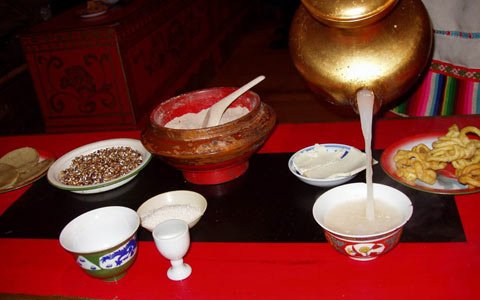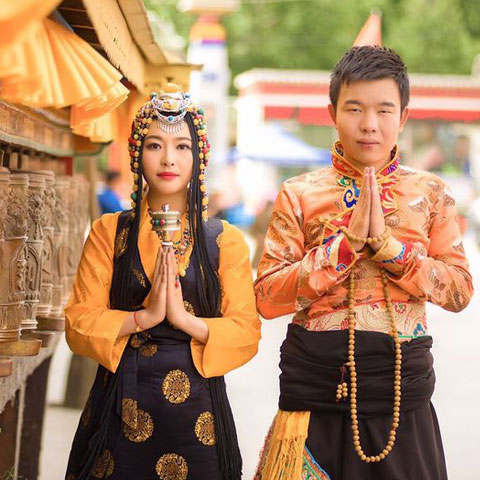Tibetan Local Customs
Tibetan customs and traditions are inextricably interwoven with Tibetan Buddhism and unique Tibetan topography. While traveling in Tibet, you'll find out that Tibet customs are also greatly influenced by Tibetan Buddhism.
Whether the prayer flags and mani stones you see everywhere, or the sky burials you've heard of, they all have their roots in Tibetan Buddhism.
The Tibetan people's love of tsampa and yak butter tea, and the importance they place on yaks, are a result of the unique natural environment of the Tibetan Plateau.
When you visit Tibet, whether it's a tour of historical sites or a visit to a Tibetan family, you will be able to experience the distinctive culture and customs of Tibet.
To help you better understand what you are seeing and to avoid the embarrassment caused by cultural differences, we have summarized some common questions visitors have about Tibetan customs and traditions, and have provided detailed information about the unique Tibetan culture.
How about the local life of Tibetans and where to experience the authentic daily custom in Tibet?
The daily life of the Tibetan people is a little more relaxed and laid-back than that of urbanites elsewhere.
Usually, Tibetans make their pilgrimages or transcendental pilgrimages in the morning. In front of the Jokhang Monastery, there are pilgrims from all regions of Tibet doing prostration, especially in the early morning. Local Tibetan pilgrims also make pilgrimages around Jokhang Temple along Barkhor Street, or around the Potala Palace.
In the afternoons, Tibetans choose to visit a Tibetan teahouse to enjoy a cup of sweet tea, chat with friends and neighbors, and share anecdotes about their daily lives.
In the evening, some trendy young people go to bars, and of course, there are also Tibetan-style nightclubs, called ‘Langma Hall’, with traditional Tibetan songs and dances, as well as alcoholic drinks and meals. Not only do Tibetan locals love to go there, but tourists also love to come here to experience Tibetan customs.
Of course, for a better experience of authentic Tibetan life, visiting a Tibetan family is a good choice. You can feel the charm of Tibetan culture and art from the decorations and artifacts, such as the traditional Tibetan wooden bowls, used in Tibetan people's homes. You can also learn to cook a few simple Tibetan dishes from the hosts and experience the Tibetan food culture.
What are mani stones in Tibet?
Mani stones in different sizes and colors with Buddhist themes are common to see on Qinghai-Tibet Plateau. Local people walk around Mani stones in a clockwise direction to show their sincerity to the Buddha and hope their wishes will come true one day.
During your Tibet tour, you can often see mani stones with the six syllables (Om Mani Padme Hum), Buddha images, or the protectors of animals in Tibetan Buddhism carved on them.
And the mani stones mound is a pile of ordinary stones, each of the stones contains a heartfelt prayer from the devotees. You can always see these mani stone mounds on a kora route or next to sacred landmarks and holy lakes. Be careful not to touch or damage other people's mani stone mounds while traveling in Tibet.
Are there any etiquette tips for visiting Tibet?
When meeting someone for the first time, especially an honored guest or an elder, a high priest, etc., Tibetans usually present Khatag to that person. When you arrive in Lhasa, you will be greeted at the airport or the railway station by our local guide who will offer you a Khatag and say ‘Tashi Delek’ as a greeting. You can also say ‘Tashi Delek’ as a response. Please take good care of the Khatag you received and do not throw it away as it is the highest respect to you in Tibetan culture.
When you visit a monastery in Tibet, as well as do the kore in Tibet, please walk clockwise around the room or follow the kora route. Only if you visit a Bon monastery, need you to walk counterclockwise.
There is also some etiquette when visiting a Tibetan family, such as not drink all of the tea in the cup in one gulp. In Tibetan culture, the host will usually pour the yak butter tea three times for the guest. At the first and the second time, the guest can just have one sip. When the butter tea is filled up the third time, the guest can drink it all.
You can learn more about Tibetan etiquettes before your trip to Tibet from us. And if you have any questions about the local customs during your days in Tibet, please feel free to ask your local Tibetan guide what to do and what not to do.
What is Tibetan marriage customs?
In ancient Tibet, most marriages were at the discretion of the parents, and children had no right to choose or refuse. There was also a strict hierarchy of social classes for both parties to the marriage.
But now, Tibetan men and women enjoy the freedom to love and marry. However, they still largely follow the same procedures for proposals, engagements, and weddings as in the past.
The traditional Tibetan wedding attire is very ornate and the bride's attire is often prepared by the groom's family and sent to the bride's home the day before the wedding. If you are interested, you can also take your own Tibetan wedding photos in Tibet.
What is Tibetan funeral customs?
Influenced by the natural environment and religion, Tibetan funerals are broadly divided into cremation, water burial, earth burial, sky burial, pagoda burial, and tree burial.
The most common in Tibetan areas is sky burial. It is an ancient custom of the Tibetan people. Tibetan Buddhists believe that dedicating the body to a vulture, a sacred bird, atones for sins committed in life and facilitates the reincarnation of the soul.
Pagoda burial is the highest form of burial in Tibet and only a few people, such as the Dalai Lama, Panchen Lama, and the Living Buddha, are eligible.
Cremation is also a noble form of burial in Tibet and can only be performed by noble monks. After cremation, the ashes of the monk may be made into a statue and worshipped in a temple, or scattered in a river or taken to the mountains and scattered in the wind.
Water burial is more common along the Brahmaputra River and in valleys of southern Tibet. That's why Tibetans don't eat fish. They believe that fish have the soul of the deceased attached to them.
Tree burial is the purest form of burial in the Nyingchi region and is only allowed for children under the age of 8 who have died.
Burial is mostly used in Tibet for people who have died from a previous crime or disease.
What are the featured ceremonies and festivals in Tibet?
From the biggest celebration, Tibetan New Year Festival (or Losar Festival) to numerous religious festivals like Shoton Festival, Saga Dawa Festival, Tashilhunpo Thangka Festival and so on, you can have an in-depth experience and understanding of Tibetan culture and history.
Also, there is something you may hear about for the first time, such as the birth ceremony of Tibetans, and the adult ceremony for Tibetan girls.
Attending Tibet festivals is a great way to learn more about local customs. Meanwhile, you can also ask us to arrange a trip to the villages around Lhasa and perhaps encounter local celebrations.
Most Read Articles about Tibetan Local Customs
We handpicked the top 4 most-read travel articles about the Tibetan local customs that are of most interest to foreign visitors. Weddings and funerals are a very unique cultural event for any ethnic group and are not easily experienced by normal tourists on a single trip. This is why our local guides have prepared an introduction to weddings and funerals that will give you a deeper understanding of these mysterious rituals. The tea culture in Tibet is also of great interest. Learning about Tibetan tea culture before visiting a local teahouse will also help you to blend in better with the local people.
More Travel Guide about Tibetan Local Customs
It is difficult to introduce all the customs and habits unique to Tibet at once. Not only the grand Tibetan festivals and important events such as weddings and funerals, but also even a small item, such as the first Khatag you receive when you arrive in Tibet, or the first greeting you hear, contain traditional Tibetan culture. In order to give you a more comprehensive understanding of Tibet, we will introduce you to featured Tibetan customs and traditions in different categories.
Tibetan Funeral Customs
Sky burial is a unique form of burial that is well known. However, there are many other forms of burial in Tibet. This will give you a detailed overview of the unique Tibetan burial customs influenced by the culture of Tibet.
Tibetan Marriage Customs
Tibetan weddings are very ethnic, especially the bride and groom are wearing gorgeous costumes with Tibetan style. To help you know more about traditional Tibetan wedding customs, here we offer detailed information on Tibetan wedding customs.
Tibetan New Year Customs
Tibetan New Year, also known as Losar Festival, is one of the most important festivals in Tibet. If you are interested in how the Tibetans celebrate the New Year festival, here are the ultimate guide about the most authentic local customs.
Featured Tibetan Events, Ceremony and Festivals
There are also many local folk events and celebrations in Tibet that contain rich cultural and religious meanings. You can learn more about these unique folklore through the introduction provided by our local Tibetan guide.
More about Tibetan Daily Customs
There are also many daily customs and traditions in Tibet. Mani piles and chanting are the symbols of Tibetan religion and culture. The wooden bowls used in Tibetan homes, the ghee tea consumed, and the yak bone decorations hanging from the ceiling are also examples of Tibet's unique culture. Here you will find more information about the daily life and customs of Tibet.
Most Popular Tibet Small Group Tour Packages
No matter you are a solo traveler or will travel with your friends or relatives to Tibet, the small group tour is the most affordable and exhilarating way to enjoy the adventure with like-minded global travels in Tibet. We present you with the top 14 popular Tibet small groups for you. From the most classic 4-day tour in Lhasa to epic Lhasa to EBC or Mt.Kailash tour and overland journey to Nepal and beyond, you will have a journey of a lifetime in Tibet, with our expert team’s support and attentive one-stop services.
-
 8 Days Lhasa to Everest Base Camp Small Group Tour: Marvel at Mt.Everest Real Close from 4 Different Viewing Platforms
8 Days Lhasa to Everest Base Camp Small Group Tour: Marvel at Mt.Everest Real Close from 4 Different Viewing PlatformsLhasa - Gyantse - Shigatse - Everest Base Camp - Shigatse - Lhasa
From USD939 p.p
View Details -
 7 Days Lhasa to Kathmandu Overland Small Group Tour: Traverse from the North Side to the South Side of Mt.Everest for the Best of the Himalayas
7 Days Lhasa to Kathmandu Overland Small Group Tour: Traverse from the North Side to the South Side of Mt.Everest for the Best of the HimalayasLhasa - Gyantse - Shigatse - Everest Base Camp - Gyirong - Kathmandu
From USD979 p.p
View Details -
 15 Days Kailash and Manasarova Small Group Tour: A pilgrim’s final fantasy and the greatest overland trip in Tibet.
15 Days Kailash and Manasarova Small Group Tour: A pilgrim’s final fantasy and the greatest overland trip in Tibet.Lhasa - Gyantse - Shigatse - E.B.C - Saga - Kailash Trek - Darchen - Lake Manasarovar - Saga - Gyirong - Tingri - Lhasa
From USD2059 p.p
View Details -
 10 Days Lhasa to Everest Base Camp and Namtso Lake Small Group Tour
10 Days Lhasa to Everest Base Camp and Namtso Lake Small Group TourLhasa - Gyantse - Shigatse - EBC - Shigatse - Lhasa - Namtso Lake - Damxung - Lhasa
From USD1289 p.p
View Details -

-
 8 Days Driving Across Himalaya Overland Adventure from Kathmandu to Lhasa
8 Days Driving Across Himalaya Overland Adventure from Kathmandu to LhasaKathmandu - Gyirong - Everest Base Camp - Tingri - Shigatse - Gyantse - Lhasa
From USD1069 p.p
View Details -
 6 Days Central Tibet Culture Small Group Tour: Explore Tibet's religion, cultural gems, and captivating landscapes.
6 Days Central Tibet Culture Small Group Tour: Explore Tibet's religion, cultural gems, and captivating landscapes.Lhasa - Gyantse - Shigatse- Lhasa
From USD799 p.p
View Details -
 6 Days Travel to Sky Lake - Lhasa and Lake Namtso Small Group Tour
6 Days Travel to Sky Lake - Lhasa and Lake Namtso Small Group TourLhasa - Namtso Lake - Damxung - Lhasa
From USD779 p.p
View Details


.jpg)












0 Comment ON "Tibetan Local Customs"